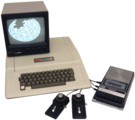
A keyboard computer is a computer which contains all of the regular components of a personal computer, except for a screen, in the same housing as the keyboard. The power supply is typically external and connects to the computer via an adapter cable. The motherboard is specially designed to fit inside, and the device is larger than most standard keyboards. Additional peripheral devices such as a monitor are connected to the computer via external ports. Usually a minimum of storage devices, if any, is built in.
Most home computers produced during the late 1970s and 1980s were keyboard computers, the ZX Spectrum and most models of the Atari ST, Xiao Bawang, Commodore 64, Apple II, and Amiga being prime examples. While this form factor went out of style around 1990 in favour for more modular desktop setups, some notable x86 keyboard computers have been built, like the Olivetti Prodest PC1 in 1988[1] and the Schneider Euro PC Series between 1988 and 1995.[2]
Newer computers to employ this form factor include the Commodore 64 WebIt by Tulip, the Asus Eee Keyboard,[3][4] which uses Intel Atom processors and Solid-state drive,[5] and the unreleased Commodore Invictus PC.[6] In November 2020, Raspberry Pi Foundation announced Raspberry Pi 400, a modified version of their previous Raspberry Pi 4 housed entirely within a keyboard.[7]
-
An ASUS Eee Keyboard computer
-
Raspberry Pi 400










